To say Sheffield Wednesday are having a tough time would be an understatement.
On and off the pitch, the Owls have had their fair share of destruction.
Of course, there’s the ongoing situation with owner Dejphon Chansiri, which has only mirrored Wednesday’s lacklustre season on the pitch for the most part this season.
This season is the club’s first time back in the EFL Championship since 2020/21 – Darren Moore guided the club to promotion via the playoffs last season but shockingly walked out of the club shortly after.
The former Doncaster Rovers man was then replaced by Xisco Muñoz, but he was sacked after just 12 games, in which he failed to collect a single victory.
Eyebrows were raised when 34-year-old Danny Röhl was appointed as the club’s next manager – the German coach’s first-ever managerial job.
His coaching CV was the only thing providing hope for Wednesday fans as he had no previous managerial experience to be judged on – Röhl has previously worked as a first-team coach at clubs like RB Leipzig, Southampton, and Bayern Munich; he has also served as the German national team’s assistant manager, so his coaching pedigree cannot be disputed.
Despite a tricky start to life in South Yorkshire in terms of results, fans were encouraged by the noticeable improvement in performance, which seems to grow week by week.
Shortly into Röhl’s reign, assistant manager Chris Powell urged the club’s fans to be patient with the EFL’s youngest manager, and it looks like their patience is starting to pay dividends, with the club currently on an unbeaten run of three games, winning two, and drawing to promotion favourites Leicester City.
This scout report will provide a Danny Röhl tactical analysis of how Röhl’s Wednesday side have played in those three games as we look to pinpoint the key tactics behind the Owls’ transformation in form.
Off-the-ball intensity
One of the most glaring differences in a Sheffield Wednesday performance now is how they approach things out of possession.
In a short space of time, Röhl has instilled a tremendous work rate and unit cohesion to close the opposition down at the right moments.
This segment of analysis discusses some of the key elements in Wednesday’s pressing.
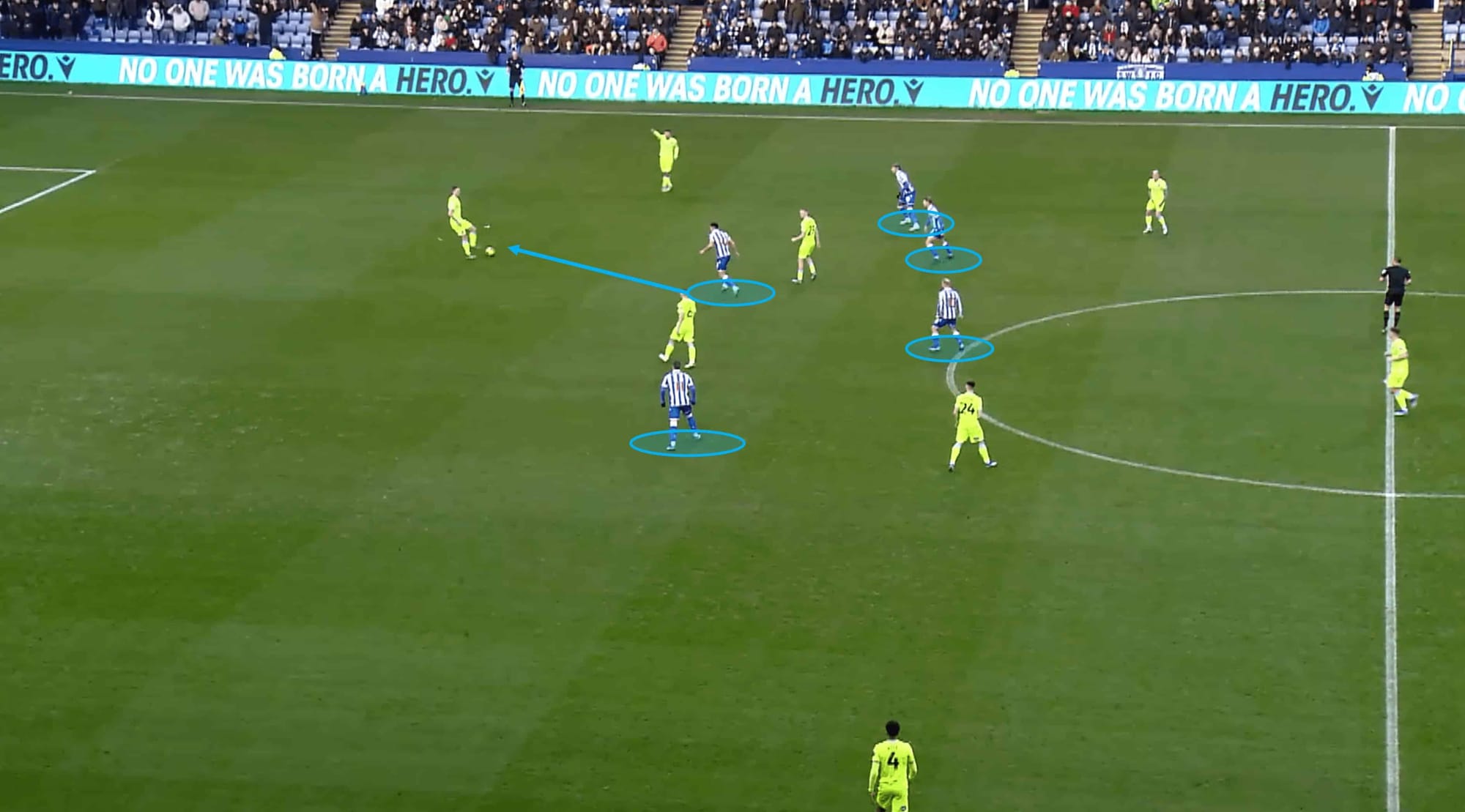
Perhaps the most striking thing about the image above is the narrow width of the Wednesday pressing group.
This particular move aims to stop Blackburn from being able to play out into the midfield, massively halting their attacking prospects.
More often than not, academy product Bailey Cadamarteri, in that lone striker role, has the job of pressing the opposition defenders, with the widest of the midfield block closing the full-backs down when required.
Interestingly, Wednesday executed this move immediately following a Blackburn kick-off – another indicator of Röhl’s intent and tactical ideologies.
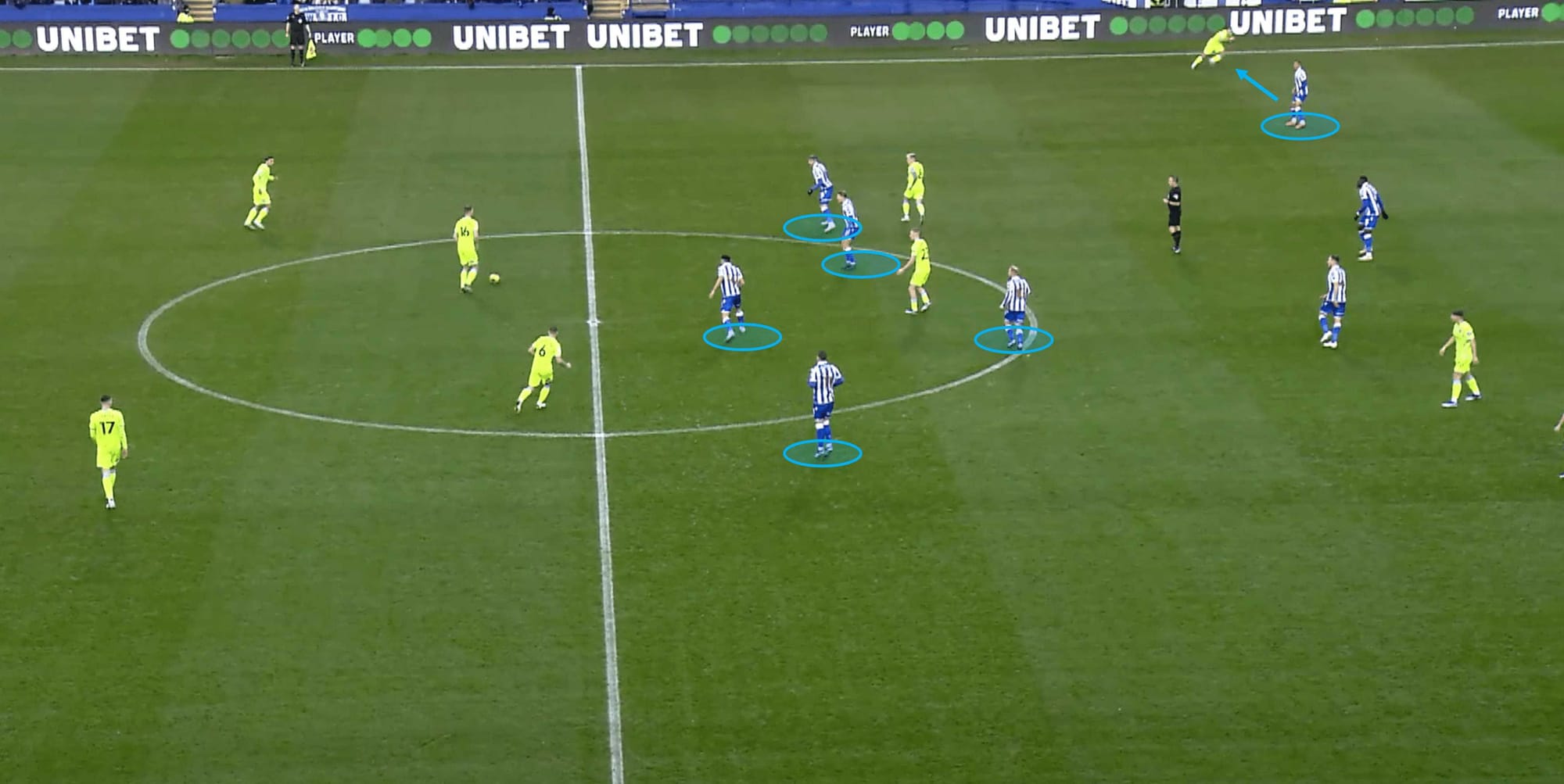
This move appeared frequently against Blackburn – a move explicitly tailored to combat Rovers’ tactics, a clever move by Röhl and a testament to the work done behind the scenes to tactically prepare for this.
Teams shaping up this way is not a common sight.
Sure, Wednesday’s CF and midfield unit have dropped deeper in this example and are awaiting the right moment to close the ball down, but Wednesday’s back line remained at a good depth, putting the Owls into a mid-block.
As before, the narrow shape from the front pressing group is to stop Blackburn from playing into the midfielders, making it difficult to build an attack.
Their wide men were pushed far up the pitch, which, of course, poses a potential threat, but the Wednesday full-backs deal with this as any full-back would and simply mark that danger.
But notice the lack of a Blackburn presence in the areas where you would expect to find the RB/LB – there is nobody there, so there is no need for Wednesday to have players out there right now, especially when they can be put to better use in a central position.
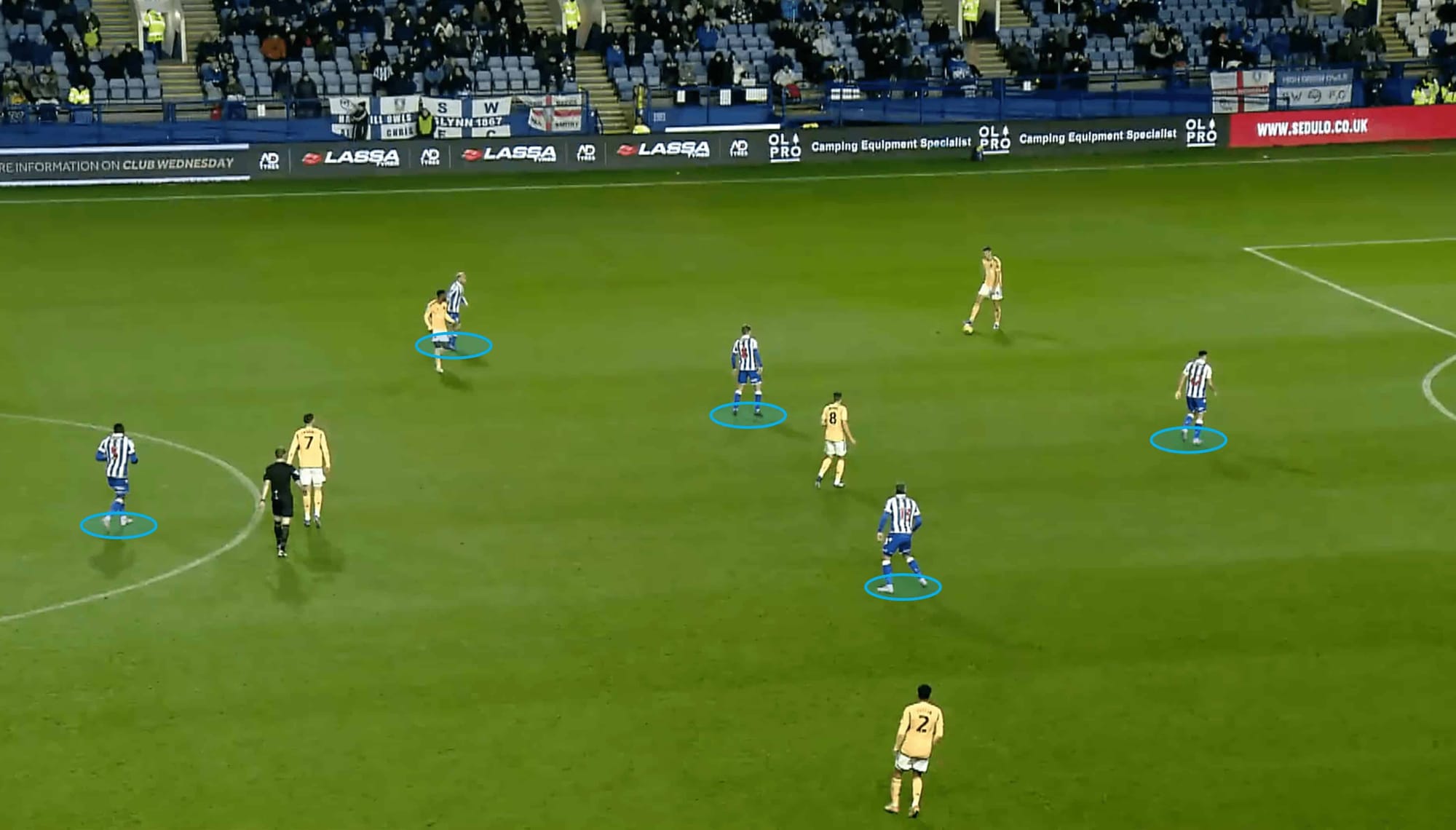
This next example occurred in the game against Leicester City, a well-deserved 1-1 draw against one of the most feared teams in the Championship this season.
We mentioned earlier that Röhl deployed a tactic that was tailored to combatting the opposition’s predicted tactics, and we see another example of that here.
Tactical flexibility and versatility are critical components of Röhl’s philosophy, and he knows how to set his team up accordingly.
This time, the midfield unit is far less narrow than the previous examples, yet still positioned high up the pitch.
However, they are also less active in the sense that their aggression levels are lower – waiting for Leicester to make their next move, which has been made difficult by the Owls’ marking and positioning.
However, the aggression and intensity do return once a trigger occurs – in this case, Wednesday were triggered by Leicester’s passing around the back.
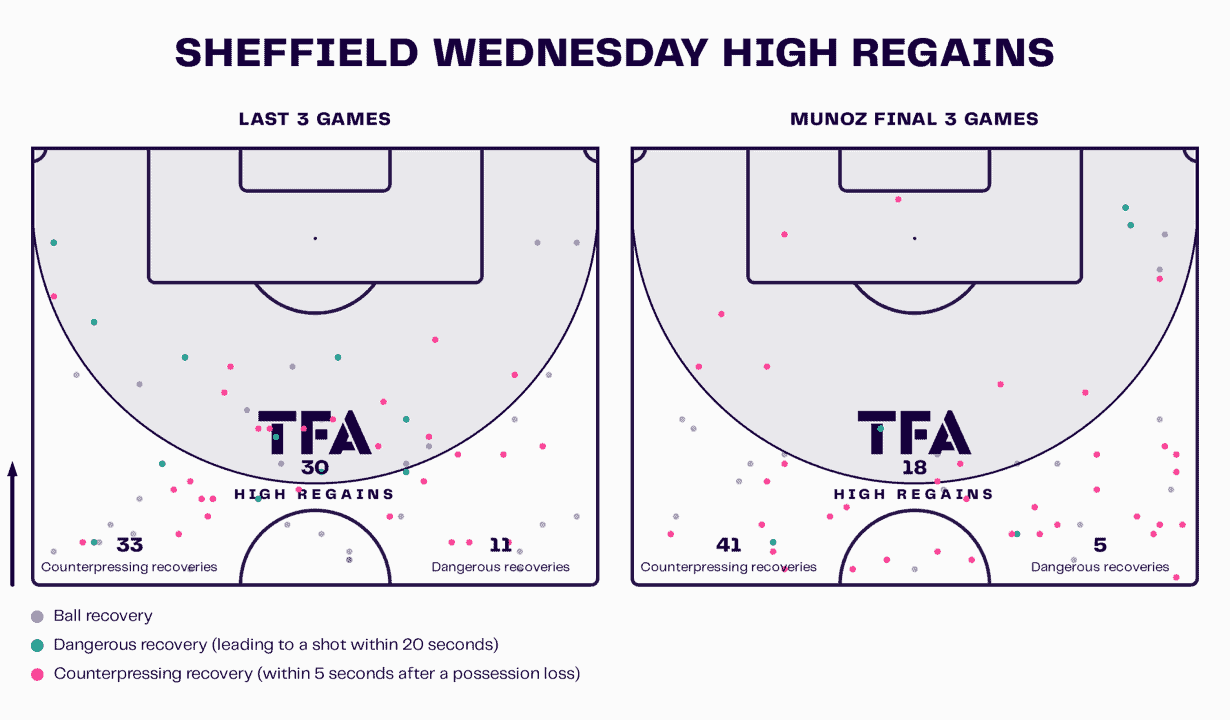
We are focusing on Röhl’s most recent three fixtures as Wednesday boss due to the pickup in form but also the increase in performance quality, as it looks like he is really building something at Hillsborough.
When comparing Wednesday’s pressing stats in that time frame to the final three games during the Muñoz era, you see a stark difference – a difference that really paints a picture of the confidence Röhl has instilled into this team.
While Röhl’s side have made slightly fewer counterpressing recoveries in the three games compared to Muñoz’s, they are far more effective in making recoveries in the final third as well as making dangerous recoveries.
This highlights Wednesday’s ability to execute a press and use the ball to good impact afterward.
Attacking transitions & general improvement in front of goal
Being impactful during attacking transitions goes hand in hand with a high-intensity pressing approach of the ball, and Röhl seems well aware of this.
The Owls have displayed a fresh hunger and determination in their performances since the German coach arrived, and that carries into their team ability in attacking transitions.
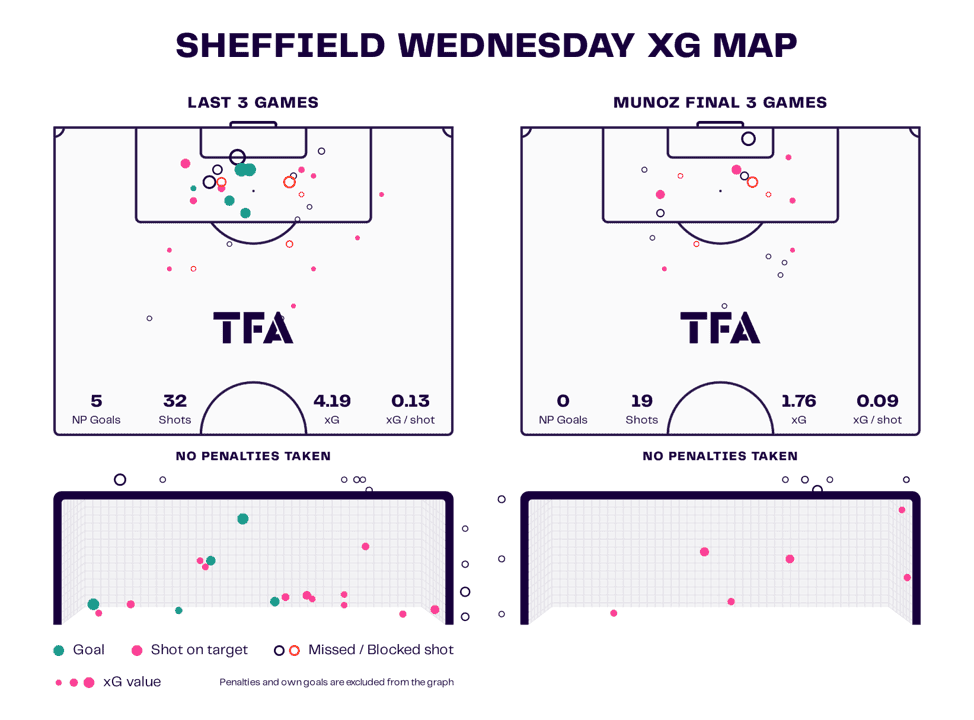
This is another comparison of Röhl’s most recent three games against Muñoz’s last three, summarising the club’s improvement.
Under Muñoz, the Owls seriously lacked tactical direction, which severely impacted squad confidence, and losing was quickly becoming a habit – as was their struggle in front of goal.
Now, Wednesday aren’t blowing opponents away with huge scorelines, but they are creating more chances of higher quality and scoring more goals, and that looks like it will only continue to improve as Röhl gets more time to work with his players.
Wednesday still have the league’s lowest goal tally, netting just 13 times in 20 games.
However, eight goals have been scored under Röhl’s leadership – compared to five goals in 11 games under Muñoz.
These attacking improvements have already started to claw back some vital points for the Owls: both managers earned two clean sheets this season in their respective reigns, but while Muñoz’s both came in 0-0 draws, Röhl won both of his clean sheet games.
Wednesday have shown attacking quality this season, especially in attacking transitions, which is why we included this goal breakdown in this segment of analysis.
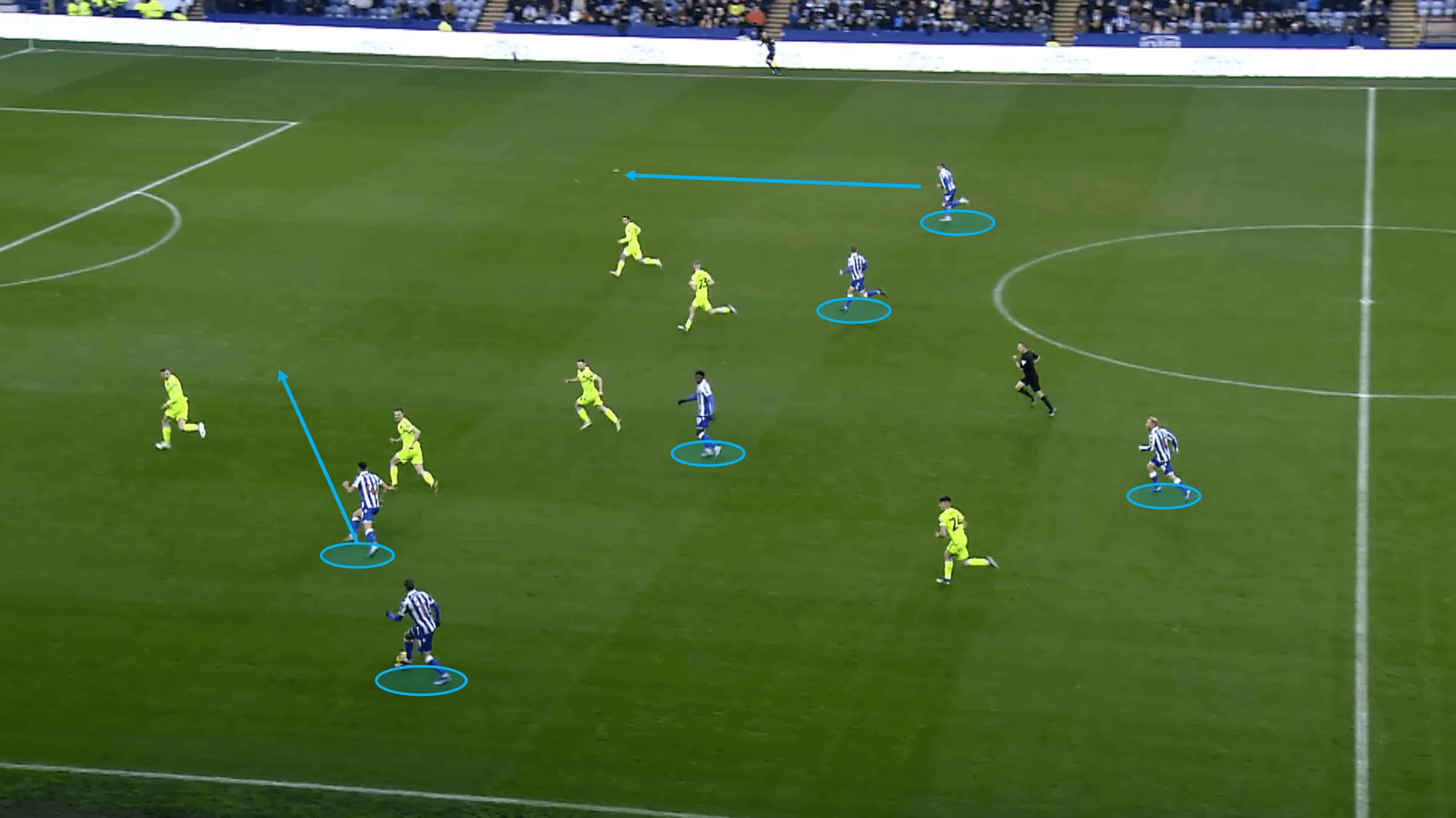
We’ve analysed their intensity and success in executing a press and making recoveries, but what do they do when they win the ball back? Usually, when the opportunity is present, they instantly look to attack.
These moments are the ones that really prove the rise in confidence within the squad but also how quickly the players have bought into Röhl’s ideas.
In a Wednesday breakaway attack, expect to see several players present, including most of the midfield unit.
Runners in wide areas add another dimension to the attack, and Cadamarteri’s hunger to get into dangerous spaces gives the opposition defence something to consider.
While often hanging back, the midfielders offer a strong supporting presence to the attack and make it hard for the opponent to clear the danger.
Their off-the-ball movement has been a critical part of their attacking success and will likely be something Röhl looks to utilise going forward, regardless of whichever tactical direction he takes from week to week.
Midfield shape in build-up phases
So far, Danny Röhl has been opting for 4-3-3 or 4-1-4-1, which, as you can imagine, sees differences in shape and positioning, but the principles and aims remain largely the same, and that is no exception with the midfield unit.
That unit has been crucial to Wednesday’s possession phases and has helped provide a tactical identity via its unique shape and positioning.
We discuss the role of the unit in the build-up phases in this segment while also examining Barry Bannan’s impact in the engine room.
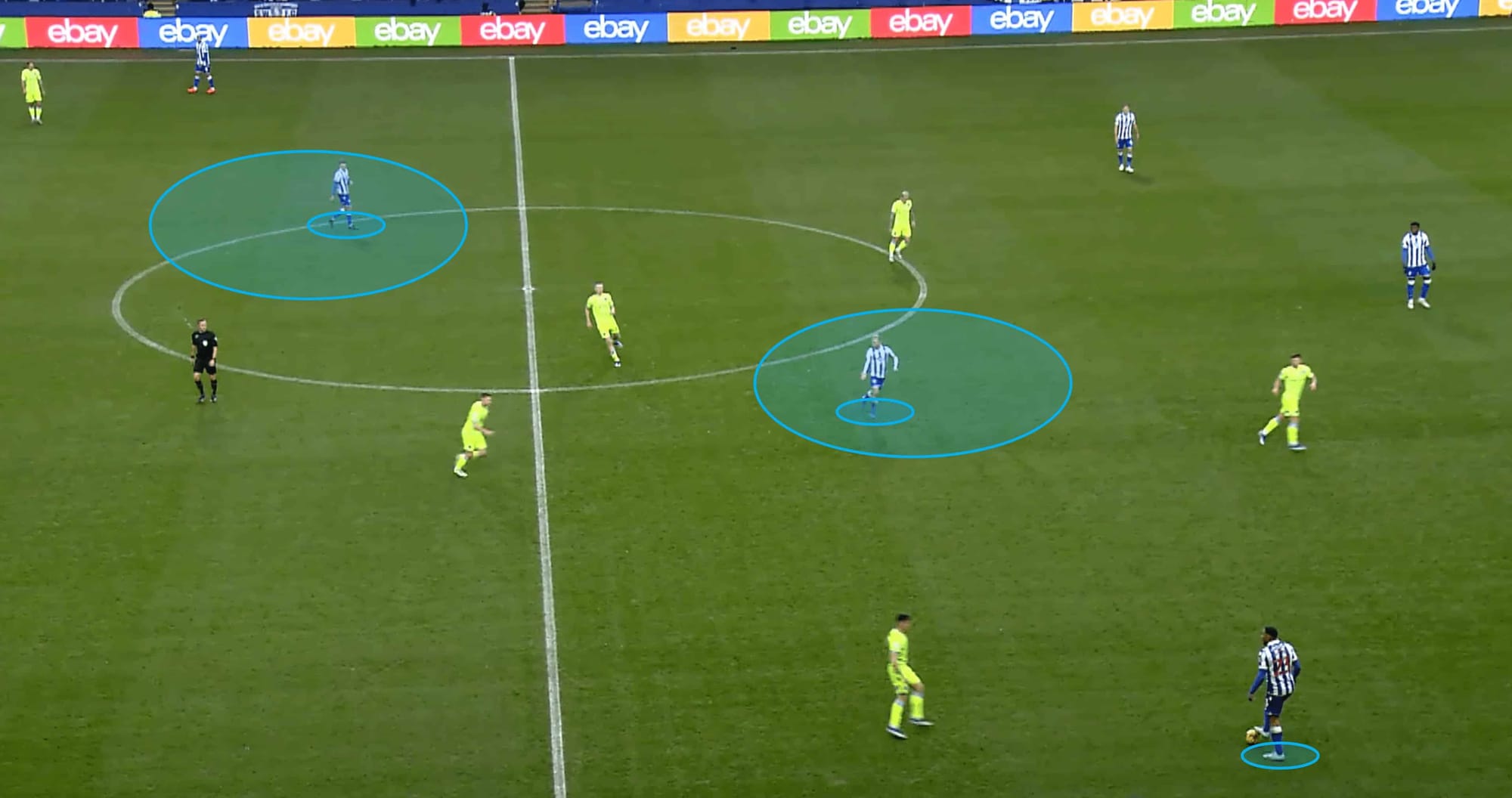
A far cry from their narrow nature out of possession that we looked at earlier, Sheffield Wednesday’s midfield unit often has the freedom to have a lot of distance between them.
This gives the Owls the element of flexibility in how they play through the midfield third, as they can take up numerous positions and angles to receive the ball from the defenders.
The space aspect also gives the opponent a headache, as these tactics have an element of unpredictability.
The example above gives you a taste of this.
Bannan is seen to drop into that deeper playmaker role, looking to be the initial close link between the back four and the midfield before playing the ball forward himself.
Notice how both Bannan and his highlighted teammate have a great deal of space – this is another advantage of the shape fluidity: the third midfielder (Wednesday played a 4-3-3 in this fixture) isn’t even in the shot he’s that far up! Certainly, an interesting and unique dimension added to Wednesday’s possession phases.
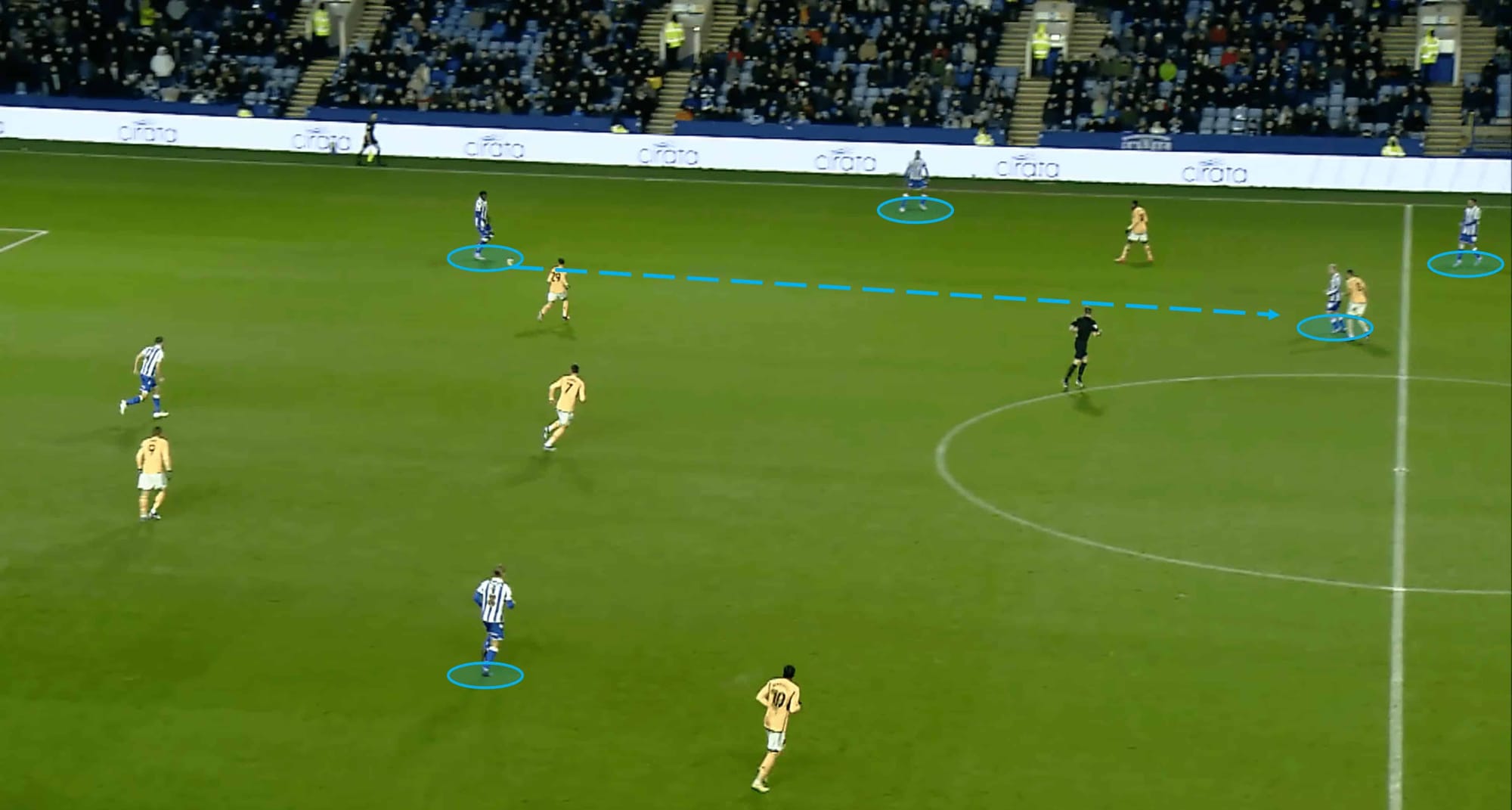
What we see more of from Wednesday’s midfield unit, whether it’s a 4-3-3 or 4-1-4-1, is Bannan positioning himself in a location where he can receive the ball and instantly combine with the full-back and/or winger on that same side.
Again, though, notice the distance between him and his highlighted midfield teammate – this forces Leicester to keep a wide shape to combat the width of Wednesday, creating space for the Owls to utilise.
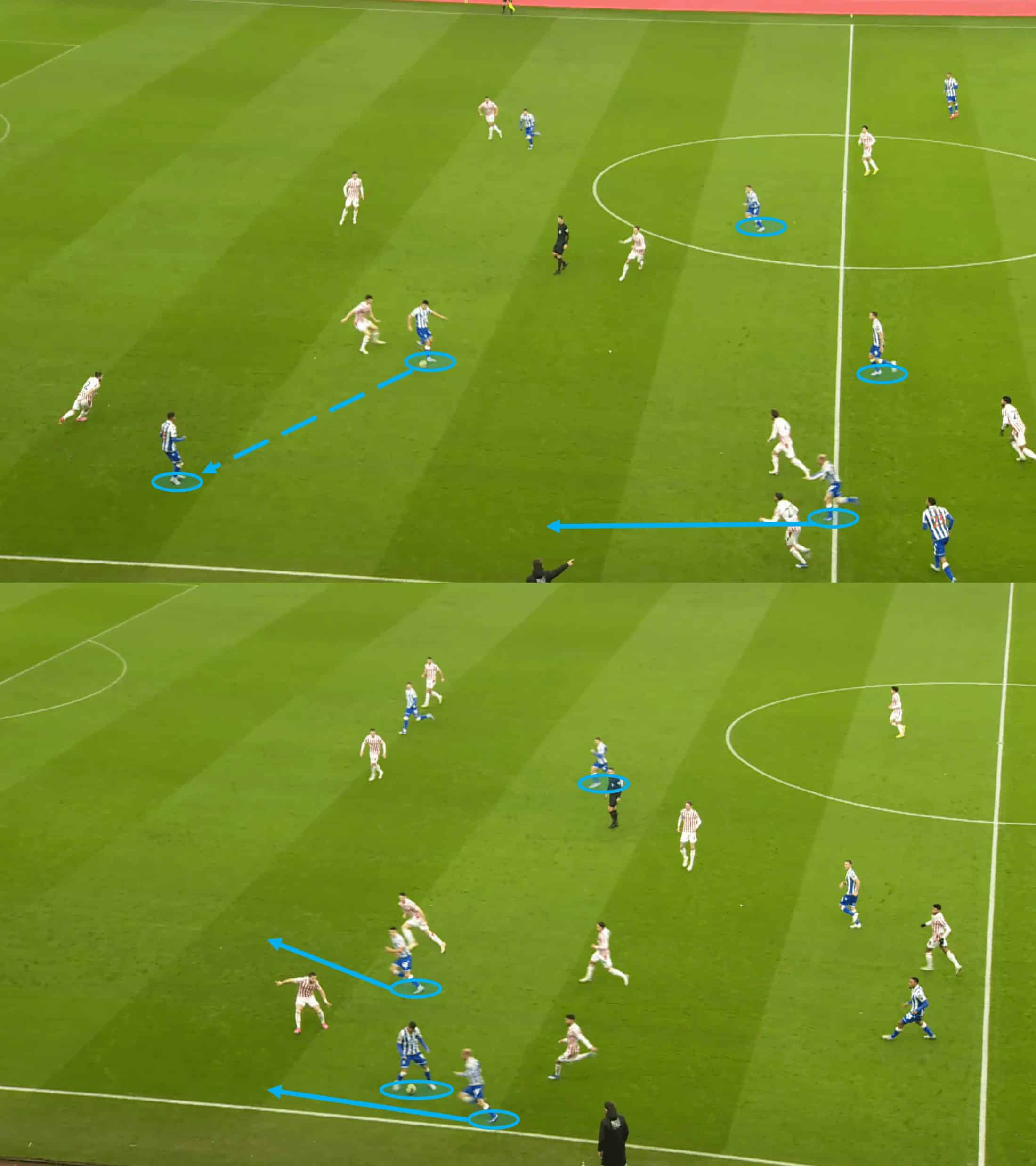
We touched on Bannan’s role in combining with the flank players, which is a crucial feature of his role under Röhl.
The Wednesday boss seems to recognise the Scottish midfielder’s technical qualities and wants to get the most out of them, which is why we see him operating in many areas across the pitch from week to week.
Bannan is no stranger to effectively becoming an extra winger on the left flank, evidenced in the analysis image above, where he can be seen combining with two teammates, making an overlapping run down the line.
While it is true that the Owls’ midfield unit has been given a good amount of freedom in general by Röhl, it seems that Bannan has been given more of a license to roam and get involved with any possession stage.
Conclusion
Sheffield Wednesday are not out of the woods yet by any stretch of the imagination, but their improvement is undeniable, and now the results are starting to reflect that.
Keeping key players fit will be difficult due to the intensity of Röhl’s tactics demand, so it may not be a surprise if the Owls look to make a couple of additions in the January transfer window to help keep things fresh.
Ironically, while Röhl is remarkably young for a Championship manager, the average age within his squad is 27.8 years – the second oldest team in the division.
Danny Röhl will undoubtedly have to tap into that experience, especially in periods of pressure.
Let’s not forget that Röhl is the youngest manager in the EFL, and while he has impressed so far, mistakes and learning curves are inevitable.
That said, it is safe to say that Wednesday fans are more hopeful about their future now than just a couple of months ago.

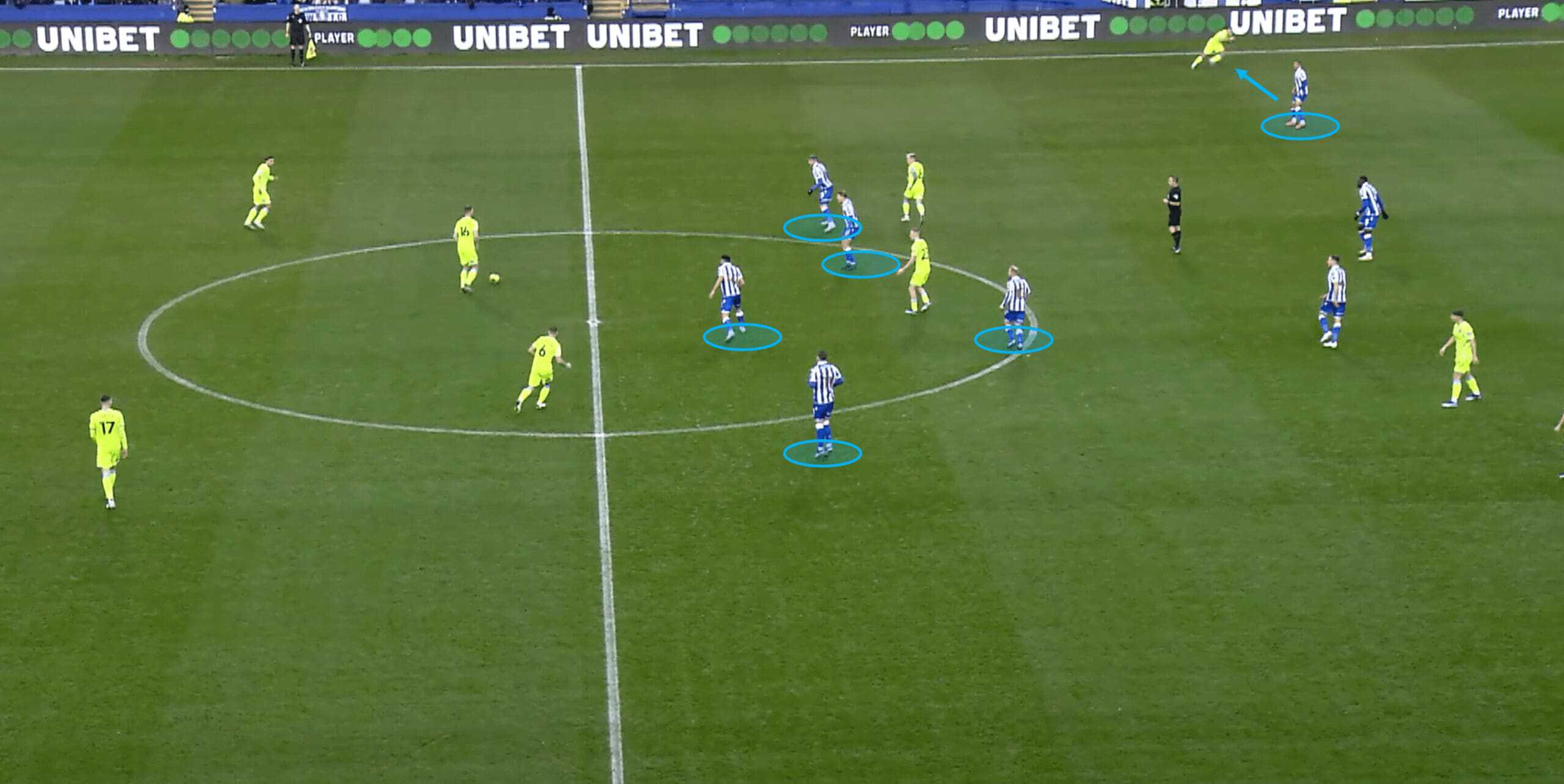




Comments